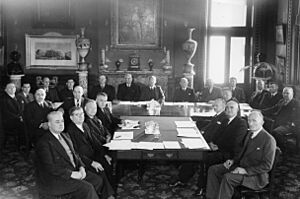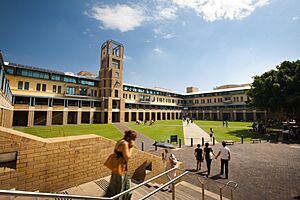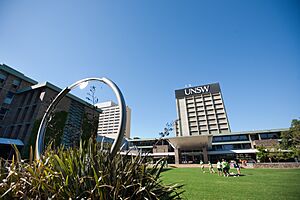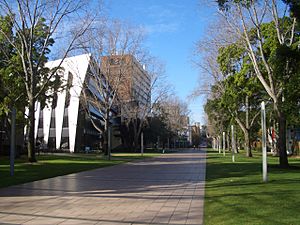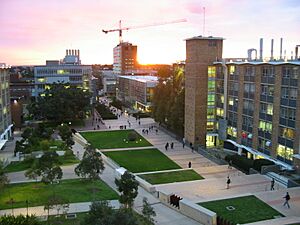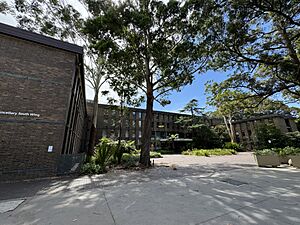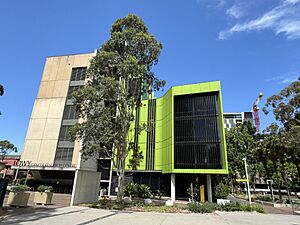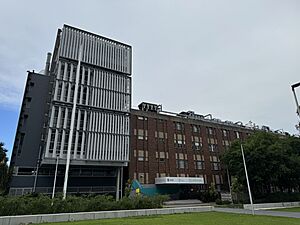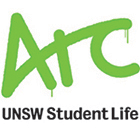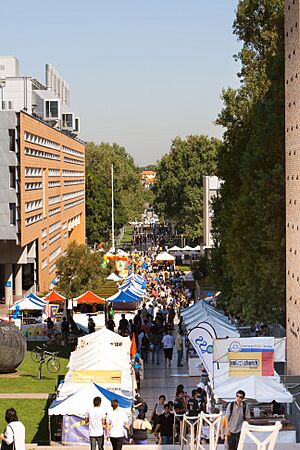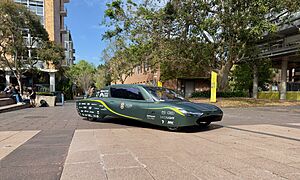University of New South Wales facts for kids

|
|
|
Former name
|
The New South Wales University of Technology (1949–1958) |
|---|---|
| Motto |
Latin: Scientia Corde Manu et Mente
|
|
Motto in English
|
"Knowledge by heart, hand and mind" |
| Type | Public research university |
| Established | 1 July 1949 |
| Accreditation | TEQSA |
|
Academic affiliations
|
|
| Endowment | A$231.63 million (2023) |
| Budget | A$3.06 billion (2024) |
| Visitor | Governor of New South Wales (ex officio) |
| Chancellor | David Gonski |
| Vice-Chancellor | Attila Brungs |
|
Academic staff
|
3,452 (2023) |
|
Administrative staff
|
4,136 (2023) |
|
Total staff
|
7,588 (2023) |
| Students | 70,238 (2023) |
| Address |
High Street
,
,
,
2052
,
|
| Campus | Urban, parkland and regional, 38 hectares (0.38 km2) |
| Colours | Yellow Black |
|
Sporting affiliations
|
|
| Mascot | Clancy the Lion |
 |
|
The University of New South Wales (UNSW) is a large public university in Sydney, New South Wales, Australia. It was started in 1949.
UNSW has seven main parts called faculties. These faculties offer different types of degrees, like bachelor's, master's, and doctoral degrees. The main campus is in Kensington, about 7 kilometers from the center of Sydney. UNSW also has other campuses and research places in different areas.
It is a founding member of the Group of Eight. This is a group of top Australian universities known for their research. UNSW is also part of Universitas 21, a worldwide network of research universities. It works with over 200 universities around the world for student exchanges and research.
Contents
History of UNSW
How UNSW Started
The idea for UNSW came from older schools like the Sydney Mechanics' School of Arts (1833) and Sydney Technical College (1878). These schools helped people learn new skills as New South Wales became more industrial.
During World War II, Australia realized how important science and technology were. After the war, the government saw a need for a university that focused on training engineers and technology experts. This led to the idea of creating the Institute of Technology in 1946.
The university was first called the "New South Wales University of Technology." It officially started in 1949 with a special law passed by the government.
Early Years and Growth
In March 1948, the first classes began with 46 students. They studied subjects like civil, mechanical, mining, and electrical engineering. These programs were new because they included hands-on training in industries. It was also unusual for universities then to require students to study humanities.
At first, the university operated from the Sydney Technical College in Ultimo. But in 1951, money was approved to build new buildings in Kensington. This is where the main campus is today. The land for the campus was given to the university in stages between 1952 and 1959.
In 1958, the university's name changed to the "University of New South Wales." This showed it was becoming a broader university, not just focused on technology. In the 1960s, new faculties for arts and medicine were added. The faculty of law started in 1971.
Leaders like Philip Baxter helped the university grow a lot. By 1968, it had grown from a small number of students to 15,000. In 1962, the university started its own book publishing company, University of New South Wales Press. This company now publishes books and runs the UNSW Bookshop.
UNSW also helped start other universities. Colleges in Newcastle (1951) and Wollongong (1961) later became the University of Newcastle and the University of Wollongong.
Recent Developments
In 2010, the Lowy Cancer Research Centre opened. It was Australia's first center to bring together researchers studying childhood and adult cancers.
In 2019, UNSW changed its academic calendar to a trimester system. This means students study three subjects in a 10-week term instead of four subjects in a 13-week semester. This change has been discussed by students and staff.
In 2012, UNSW Press celebrated 50 years and started the UNSW Bragg Prize for Science Writing. This prize encourages science writing. There is also a Bragg Student Prize for high school students.
In 2019, a new Light Rail service started, connecting the Kensington campus to the city. This made it easier for students to travel.
In 2020, the university had to make some changes due to the effects of COVID-19. In 2021, UNSW created Mentem by UNSW to help organizations train their employees.
UNSW Campuses and Buildings
The main UNSW campus is in Kensington, Sydney. It covers about 38 hectares. Most of the university's faculties are located here. The creative arts school, UNSW Art & Design, is in Paddington.
UNSW also has other campuses and research stations. These are located in places like Randwick, Coogee, Botany, and Canberra.
Main Kensington Campus
The main campus in Kensington has two parts: the upper campus and the lower campus. They are separated by a small hill. It takes about 15 minutes to walk from one end to the other.
Art & Design Campus
The UNSW School of Art & Design campus is in Paddington, Sydney. Here, students can study visual arts, design, animation, and art theory. They can also do advanced studies in fine arts and curating.
Sydney CBD Campus
UNSW opened a new campus in the CBD in 2025. It is located on George Street and offers flexible learning spaces for students and staff.
Randwick Campus
The Randwick campus is on King Street in Randwick, New South Wales.
Manly Vale Northern Beaches Campus
The Manly Vale campus is in Manly Vale, New South Wales. It hosts the Water Research Laboratory, which is part of the School of Civil and Environmental Engineering.
Canberra Campus
UNSW Canberra is in Canberra. Its students are from the Australian Defence Force military academy, ADFA. This campus focuses on defense-related, security, and engineering research.
Venues and Facilities
The university has several places for theatre and music. Many of these can be rented by the public. The UNSW Fitness and Aquatic Centre offers health and fitness services for students and the public.
How UNSW is Run
University Council
The university is managed by the University Council. This group makes sure the university meets its goals. The council has 15 members, including the Chancellor and vice-chancellor. It also includes members chosen by the government, staff, and students.
The Academic Board is in charge of academic matters. It helps set policies for teaching and research. It also approves study programs and makes sure academic standards are met.
Chancellor and Vice-Chancellor
The main leader of the university is the President and Vice-Chancellor, currently Attila Brungs. Other leaders, called deputy vice-chancellors, help manage different areas like research and student support.
Each faculty also has its own board. These boards are responsible for teaching and exams in their specific subjects.
Faculties and Departments
As of 2025, UNSW has six main faculties:
- Arts, Design & Architecture (includes schools like Art & Design, Education, and Social Sciences)
- Business (UNSW Business School)
- Engineering
- Law and Justice
- Medicine & Health
- Science
- UNSW Canberra, which includes the new UNSW Canberra City campus and the long-standing UNSW at ADFA campus.
The university also works with the National Institute of Dramatic Art.
UNSW Symbols
Coat of Arms
The university's coat of arms was given in 1952. It features a red cross with a lion and four stars, representing New South Wales. An open book with the word "SCIENTIA" (meaning "knowledge") shows the university's purpose.
The university's motto is Scientia Corde Manu et Mente. This means "Knowledge by heart, hand and mind." It combines the idea of knowledge with using your heart, hands, and mind. The original motto was "Knowledge by hand and mind," but it was updated in 2021.
Branding
In 2013, the university started using "UNSW Australia" for marketing. In 2017, it changed to "UNSW Sydney" for its main campus and "UNSW Canberra" for its Canberra campus.
Ceremonial Mace
The university has a special ceremonial mace. It is made of stainless steel and wood. It has the New South Wales coat of arms and the university's original arms. The mace was given to the university in 1962.
Academic Life at UNSW
Research Areas
UNSW has many special facilities for research, including:
- The UNSW Lowy Cancer Research Centre: This is a large center for studying childhood and adult cancers.
- The Mark Wainwright Analytical Centre: This center helps study the structure of different materials.
- UNSW Canberra Cyber: A center for research and teaching in cyber-security.
- The Sino-Australian Research Centre for Coastal Management (SARCCM): This center works with the Ocean University of China on managing coastlines.
University Rankings
UNSW is highly ranked among universities. In 2024, it was ranked #51 globally when combining different major rankings.
- In the 2026 Quacquarelli Symonds World University Rankings, UNSW was ranked #20 globally (2nd in Australia).
- In the 2025 Times Higher Education World University Rankings, it was ranked #83 globally (4th in Australia).
- In the 2024 Academic Ranking of World Universities, it was ranked #77 globally (4th in Australia).
- In the 2025–2026 U.S. News & World Report Best Global Universities, it was ranked #34 globally (3rd in Australia).
Student Success
Surveys show how well UNSW students do after graduation.
- In 2023, 85.5% of employers were happy with UNSW graduates.
- In 2023, 81.3% of undergraduate students found full-time jobs. For postgraduate students, this was 91.7%.
- The starting salary for undergraduates was about AUD$75,000, and for postgraduates, it was about AUD$120,000.
- In 2023, 71.7% of undergraduates and 78% of postgraduates were happy with their overall education experience at UNSW.
Working with Schools
UNSW helps primary and secondary school students through various competitions:
- The Australian Schools Science Competition: Part of the International Competitions and Assessments for Schools (ICAS).
- ICAS-Mathematics: A math competition for schools.
- The UNSW School Mathematics Competition: An exam that tests mathematical thinking.
- The UNSW COMPUTING ProgComp: A competition to encourage high school students in computer programming.
- The UNSW COMPUTING Robotics Workshops: Workshops that teach students about robotics using Lego NXT. UNSW also supports the RoboCup Junior competition.
Educational Assessment Australia
Educational Assessment Australia (EAA) used to be owned by UNSW. It creates and runs large-scale tests like the ICAS exams for students in many countries.
Admissions
To get into an undergraduate degree at UNSW, students usually need a certain Australian Tertiary Admission Rank (ATAR). Some programs, like medicine or law, also require special tests.
UNSW offers a "HSC Plus" scheme. This can add up to 5 bonus points to a student's score for good performance in relevant high school courses.
The university also has scholarships for high-achieving students. The Co-op program offers scholarships and industry experience. Scientia Scholarships provide $10,000 per year for top students. There are also scholarships for PhD students.
For older students (20 or older), UNSW has a University Preparation Program. This helps them meet the requirements to get into UNSW or other universities.
Student Life at UNSW
Student Union
Arc @ UNSW Limited is the main student organization at UNSW. It is a not-for-profit company.
In 2006, several student organizations merged to form Arc. Arc supports student clubs, volunteer programs, and student publications. It also runs two student art galleries.
Arc operates the Roundhouse entertainment venue and a gift store. It also provides support services for students, like legal and academic help.
Arc has three main student groups:
- The Student Development Committee (SDC) supports clubs and activities.
- The Postgraduate Council (PGC) represents postgraduate students.
- The Student Representative Council (SRC) speaks for students to the university.
Arc also runs UNSW Sport and Recreation, which manages sports facilities and supports over 30 sports clubs.
Student Media
Blitz
Blitz is an online student publication by Arc @ UNSW. It started in 1988 and covers campus news and student activities. Blitz sometimes pays students for articles and photos. In 2004, an edition of Blitz was withdrawn because it contained content deemed inappropriate.
Gamamari
Tharunka was a student newspaper that started in 1953. Its name is thought to mean "message stick" in an Aboriginal language. In mid-2024, the publication changed its name to Gamamari, which means “talking for a purpose” in the Dharawal Language.
Noise@UNSW
Noise@UNSW is an independent student publication that started in early 2024. It publishes articles weekly on its website and Instagram, focusing on university news, student politics, and other issues affecting students. It also has a podcast. Noise@UNSW is run by volunteers and relies on donations.
Student Accommodation
UNSW offers many places for students to live. These include Philip Baxter College, Basser College, Goldstein College, Fig Tree Hall, Colombo House, UNSW Hall, International House, New College, Warrane College, Shalom College, Creston College, and UNSW Village.
Exchange Programs
UNSW has exchange programs with over 250 universities around the world. This allows students to study abroad for a period. Some partner universities include Princeton University, McGill University, University of California Berkeley, University of Michigan, and London School of Economics.
Student Projects
UNSW students are involved in many exciting projects:
- AtomCraft: Students are designing and building a fusion tokamak, aiming for completion by 2027.
- Sunswift Solar Racing Team: This team builds solar-powered cars. Their car, Sunswift 7, won the 2023 World Solar Challenge.
- rUNSWift: The university's team in the international RoboCup Standard Platform League competition. They have won several times.
- BLUEsat Satellite: Students are working on developing a satellite.
- Impact Engineers: A group of students who work on humanitarian engineering projects in developing communities.
- UNSW Redback Racing: UNSW's team in the Formula SAE-A Competition, which they won in 2000.
- MAVSTAR: A project to develop small aerial and ground vehicles for search and tracking.
- Developing Country Project: Students in Photovoltaic and Renewable Energy Engineering help bring electricity to villages in developing countries.
- iGEM (International Genetically Engineered Machine): A worldwide synthetic biology competition.
UNSW College
UNSW College, also known as UNSW Global, is a not-for-profit organization. It provides education, training, and consulting services. It also creates exams for students in many countries, from Year 3 to Year 12, in subjects like English, math, and science.
Notable People from UNSW
Famous Alumni
Many well-known people have studied at UNSW:
Politicians
- Scott Morrison, former Prime Minister of Australia
- Gladys Berejiklian, former Premier of New South Wales
- Bob Carr, former Minister of Foreign Affairs and Premier of New South Wales
- Sussan Ley, Leader of the Liberal Party
- Robert McClelland, former attorney-general of Australia
- Kerry Nettle, Australian Greens senator
- Campbell Newman, former Premier of Queensland
- Marise Payne, senator for New South Wales and Minister for Foreign Affairs
- Lucy Turnbull, former Lord Mayor of Sydney
Other Notable People
- Solina Chau, a billionaire businesswoman
- Mark Bouris, CEO of Yellow Brick Road and TV personality
- Mike Cannon-Brookes, CEO of software company Atlassian
- Roger Corbett, former chairman of the Reserve Bank of Australia
- Tim Flannery, a scientist and author
- Peter Garrett, rock musician and former politician
- Rebel Wilson, actress and writer
- Karl Kruszelnicki, scientist and media presenter ("Dr Karl")
- Bob Bellear, the first Indigenous judge
- King Tupou VI of Tonga
- Jacqueline McKenzie, a famous Australian actress
- Prince Mak, a member of the Korean boyband JJCC
- Glenn Murcutt, an architect
- Mark Taylor, former captain of the Australian cricket team
- Kerry Chant, NSW Chief Health Officer
UNSW has produced more millionaires than any other Australian university, according to a 2016 survey. In 2013, Engineers Australia found that 23% of "Australia's Top 100 Influential Engineers" were UNSW graduates.
See also
 In Spanish: Universidad de Nueva Gales del Sur para niños
In Spanish: Universidad de Nueva Gales del Sur para niños
- ARC Training Centre for Composites
- Initiative
- UNSW College


